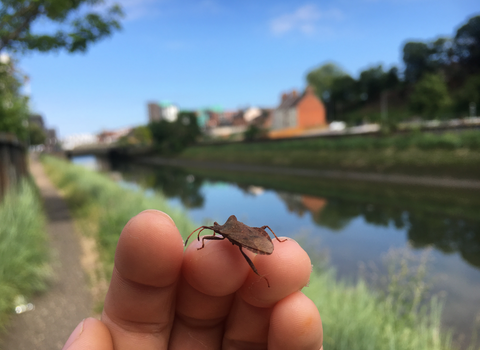You can help build a picture of the state of nature in Suffolk by identifying and recording your wildlife sightings.
How to identify a species
Whilst some species are relatively simple to recognise and identify, others can be trickier. There are a number of ways you can find out the exact species of something you have sighted:
- Use The Wildlife Trusts' ID guides. The Wildlife Trusts' website has a comprehensive set of identification guides which you can use. Compare the photos with what you have sighted to help narrow down your search. Visit www.wildlifetrusts.org/wildlife/how-identify
- Use a search engine. In a search engine - such as a Google, Bing, or DuckDuckGo - try typing a description of the species to bring up results that may match what you have sighted. For example: small brown bird with speckled chest uk. If you were lucky to take a photo of your sighting, some search engines allow you to search by uploading a photo.
- Use an identification app. There is a huge range of identification apps available to download to your mobile phone or tablet. Herts & Middlesex Wildlife Trust have some great recommendations on their website: www.hertswildlifetrust.org.uk/blog/amazing-nature-identification-apps
- Ask us! If you're really struggling, you can send a photo, video, or audio recording to us and we will try to identify your sighting for you. Email us on teamwilder@suffolkwildlifetrust.org
How to record wildlife sightings
Suffolk Wildlife Trust has teamed up with iRecord: an online species recording system created by the National Biodiversity Network. Using iRecord means your records can be collated, checked by experts, and used to support research and decision-making.
We also recommend submitting your sightings to Suffolk Biodiversity Information Service (SBIS). SBIS is Suffolk's official biological data centre with over 6 million records; they collate, manage, and share species and site data to help inform better decisions and actions to benefit Suffolk's wildlife. Visit www.suffolkbis.org.uk/record/node/7107
County species recorders
Use the drop-downs below to find the official County Recorders for Suffolk. These volunteers are experts in their species area, and most are members of the Suffolk Naturalists' Society.
Amphibians and reptiles
Amphibians and reptiles
John Baker
63A The Thoroughfare,
Halesworth IP19 8AR
reptiles@sns.org.uk
Birds
Birds (West Suffolk)
Colin Jakes
7 Maltward Drive,
Bury St Edmunds IP33 3XN
Birds (South-East Suffolk)
Scott Mayson
8 St Edmunds Close, Springfields,
Woodbridge IP12 4UY
bird-se@sns.org.uk
Birds (North-East Suffolk)
Andrew Green
17 Cherrywood, Harleston,
Norfolk IP20 9LP
bird-ne@sns.org.uk
Insects
Beetles
David Nash
3 Church Lane,
Brantham CO11 1PU
coleopteran@sns.org.uk
Bugs
Nigel Cuming
bugs@sns.org.uk
33 Holly Road, Stanway,
Colchester CO3 5QL
Butterflies
Bill Stone
butterfly@sns.org.uk
Dragonflies
Adrian Parr
dragonfly@sns.org.uk
Grasshoppers and crickets
Stuart Ling
4 Oxford Road,
Ipswich IP4 1NL
stuartjling@yahoo.co.uk
Moths
Tony Prichard
3 Powling Road,
Ipswich IP3 9JR
moth@sns.org.uk/moths@sns.org.uk
Stag beetles
Colin Hawes
Suffolk Naturalists Society
c.hawes@hotmail.co.uk
Wasps, bees and ants
Adrian Knowles
Jessups Cottage, London Road,
Capel St Mary IP9 2JR
hymenoptera@sns.org.uk
Mammals
Mammals
Simone Bullion
S.W.T., Brooke House, Ashbocking,
Ipswich IP6 9JY
mammal@sns.org.uk
Plants
Plants
Martin Sanford
Ipswich Museum, High Street,
Ipswich IP1 3QH
botany@sns.org.uk
Spiders and other arachnids
Spiders and other arachnids
Paul Lee
33 Lawford Place, Lawford,
Manningtree CO11 2PT
spider@sns.org.uk

